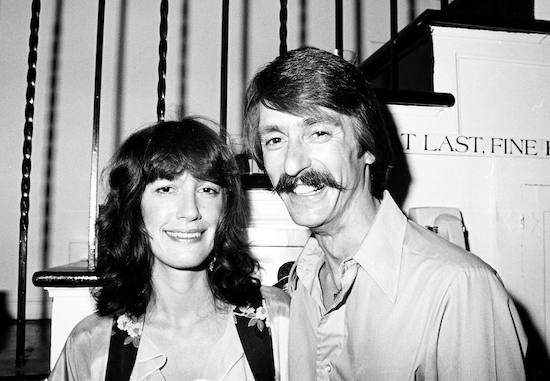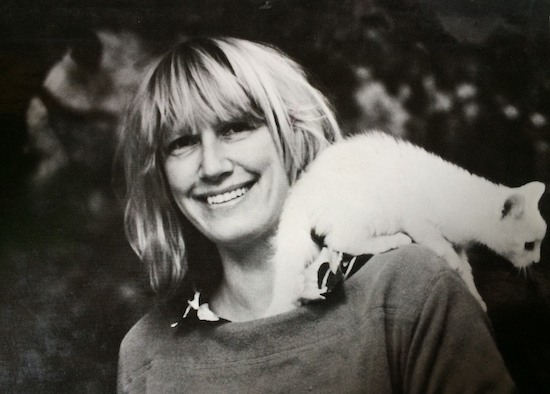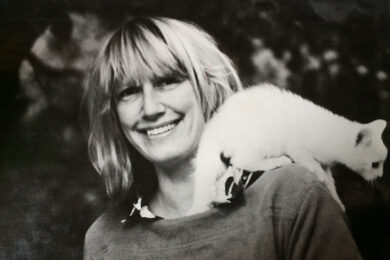The cheeringly successful re-issue of novels by Eve Babitz means that NYRB Classics have now grouped together dozens of articles she wrote for a variety of magazines, such as Rolling Stone, Playgirl, and Vogue, from 1975 to 1997.
Most articles about Eve are quick to point out that she is an extremely interesting person. Newspaper profiles tell us that her godfather was Igor Stravinsky; that she designed album covers for the Buffalo Springfield. She played chess (naked) with Marcel Duchamp (clothed). We learn too that she rated Harrison Ford highly as a lover and how she used to go out with Jim Morrison; The Lizard King duly wrote L.A. Woman inspired by their affair. Oh, and then there was the accident – but more of that later.
Eve Babitz graduated from Hollywood High “with a very strong sense that nothing on earth mattered except looks and romance”. Her biography fascinates but it is her prose that really buzzes. The folderol life of Hollywood triviality may appear as shallow as a puddle but Babitz reveled in its surface glamour. Not for her the moody brooding of her peer, Joan Didion, as typified by one of the latter’s own collection of essays, The White Album (1979). Babitz actually likes California; her joy in its excess acts as a counterforce to Didion’s more doomy prognostications. Eve loved all the city could offer…
On L.A.
She is a big fan of the Chateau Marmont and one hopes she also rates the brilliant Jarvis Cocker/Chilly Gonzales song cycle, Room 29. She loves the old hotel and “its slow elevators, high ceilings, and amazing views” and calls it “a bastion of grace holding on by its fingernails against time”. In turn she is careful not to appear deluded about the city; she knows the downtown district is “awful”; she acknowledges that San Francisco is prettier; she is gleefully candid in telling the reader, “don’t go to the Marina”. And then, channeling Proust and Steely Dan, she will convince you to get in the car: “A drive at twilight down Sunset or Wilshire or Olympic Boulevards toward the sun setting in the ocean is a very romantic Raymond Chandler thing to do.” Doing this brings “sweet romance, danger, and memories of things past (even if they aren’t your own past) into focus. And there is no smog at night”.
On Film
Another essay here is about The Godfather Part II and Eve’s experience as an extra (blink and you’ll miss her) during the Frank Pentangeli courtroom scene. Babitz sensed the grand vision of the director, the then thirty-six year old Francis Ford Coppola, and concludes: “on Francis’s side are Righteousness and Truth, Pure Untainted Visions of Ancient Glory and Modern Goodness. On the other side are the Capitalist George Grosz Money Masturbators, amassing Power in secret vaults”. This, of course, was well before he made Apocalypse Now! She also meets Walter Murch, that master of editing, and notes “what is inessential must be cut away and what remains must convince us it’s essential, not like England after it won/lost the war”. Yikes: this was her writing in 1975!
On Art
Eve hung out at the Ferus gallery run by Walter Hopps, said to be seven jumps ahead of everyone else, who knew who was “cool for all eternity”. Here she becomes part of a gang that includes the Ed’s: Kienholz and Ruscha. Larry Bell does her portrait. She meets Edie and Andy. Warhol looked like “someone you glimpsed through blue water from a diving bell, living in another element from the rest of us, the element of fame, the mantle of self-enchantment, the wings of glamour, the aura of things to come…”

On Music
She knew Jim (“Bing Crosby from hell”), she knew Janis. She grooved with Gram and Neil and Roger and Gene. Eve thought Linda Ronstadt would make a great President because she “made the world safe for Mexican music”. And the Velvet Underground? Well, they weren’t cute enough for her. She thought Mick Jagger a real man because he was “in Performance, in bed with two women, wearing eye makeup and kimonos.” The Doors were “embarrassing, like their name. I dragged Jim into bed before they’d decided on a name and tried to dissuade him; it was so corny naming yourself after something Aldous Huxley wrote. I mean, The Doors of Perception… what an Ojai-geeky-too-L.A.-pottery-glazer kind of uncool idea”.
On Men
Eve had the measure of them. Here she is on one jerk: “this tall, unfunny, unwonderful, stupid man picks me up (I could tell at once he was stupid because he was stupid)”.
On Drink and Drugs
Eve was an enthusiast. But she was savvy and recognised this wasn’t always good for her talent. She wrote sarcastically: “writing on amphetamine is tricky because Mein Kampf has been done already, better.” She could be as witty as Colette: “perhaps I should stop drinking and that way maybe some opportunities for different points of view would happen by, ones that so far had not been Mailered.”
And, just as you’re nodding away at her nifty references to the likes of Edgard Varèse or Robert Irwin, she will throw a curveball and rave about Patrick Swayze or Jackie Collins and you soon find yourself concluding – you know, maybe she’s right about them too! Babitz was never “one of those people who think critical thought is better than beauty”. Tragically there was her terrible accident in the 90s that saw her sustain major third degree burns. But she survived and wrote on. The title essay here is something she says to her carers in hospital – I used to be charming. Now that’s what you call grace under pressure. Facing death with a quip: tick! How utterly cool was that?
I Used to Be Charming by Eve Babitz is published by NYRB Classics



